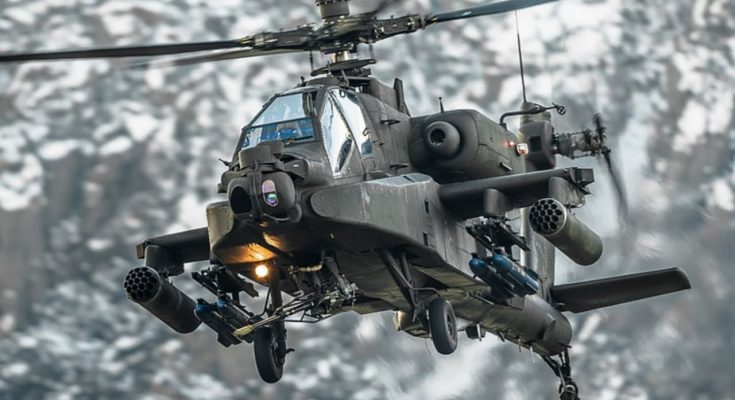The AH-64 Apache is widely regarded as one of the most successful and lethal attack helicopters in history. Developed by McDonnell Douglas (now part of Boeing) in the 1970s and entering service with the U.S. Army in 1986, the Apache has since become a symbol of air combat superiority. Its combination of advanced technology, devastating firepower, and unmatched versatility has made it a crucial asset in modern warfare. Over the years, it has been used in a wide range of operations, from counterinsurgency missions to full-scale combat engagements, securing its place as one of the most successful attack helicopters in military history.
Design and Capabilities
The AH-64 Apache is designed primarily for close air support, anti-tank warfare, and battlefield interdiction. With its twin-engine configuration and advanced avionics, it is capable of flying at speeds of up to 175 mph (280 km/h) and operating in a variety of weather conditions and at night. The Apache’s design is rugged, with a reinforced airframe and a heli-armor that provides protection against small arms fire, missile fragments, and even some armor-piercing rounds.
The most iconic feature of the Apache is its advanced targeting system. The Longbow radar system, integrated in later versions (AH-64D), allows the Apache to detect, track, and engage targets from great distances, even in poor visibility conditions. The helicopter’s ability to fire at stationary and moving targets with pinpoint accuracy is a critical factor in its success.
Firepower
The AH-64 Apache is armed with a 30mm M230 chain gun, which can fire a variety of ammunition types, including high-explosive and armor-piercing rounds. This cannon is mounted under the fuselage and is capable of devastating ground targets, including armored vehicles, infantry, and fortifications. The Apache also carries Hellfire missiles, which are precision-guided anti-tank weapons, and hydra 70 rockets for general-purpose use.
One of the Apache’s greatest strengths lies in its ability to fire these weapons while remaining relatively undetected. The helicopter’s stealthy design (including its low radar profile and reduced infrared signature) allows it to engage enemy forces at stand-off distances, often out of range of enemy air defenses. Its multirole capabilities make it an invaluable tool in both offensive and defensive operations.
Operational Successes
The Apache’s combat effectiveness was first truly proven during the Gulf War (1991), where it played a key role in neutralizing Iraqi armored forces and infrastructure. Apache helicopters were used extensively for deep-strike missions, targeting enemy tanks, radar systems, and command posts. The AH-64’s precision strikes and ability to operate in all weather conditions made it a decisive factor in the coalition’s victory.
In the years that followed, the Apache continued to demonstrate its versatility in a variety of conflicts. During the Bosnian War (1992-1995), it was used to support peacekeeping missions and enforce no-fly zones. The Apache also proved invaluable during the Iraq War (2003-2011) and the War in Afghanistan (2001-2021), where it provided close air support to ground forces, engaged enemy combatants in rugged terrain, and took part in counterinsurgency operations.
The AH-64D Apache Longbow—an upgraded version—saw increased success with its enhanced radar and avionics, which allowed for greater operational flexibility. Its ability to track multiple targets simultaneously and fire guided missiles from standoff distances was instrumental in the success of U.S. and NATO forces in these regions.
Global Reach and Legacy
The AH-64 Apache has been adopted by over 15 countries, including the United Kingdom, Saudi Arabia, Israel, and India. Its global use further cements its reputation as the premier attack helicopter in the world. In addition to its versatility in different combat theaters, the Apache’s adaptability has ensured its place as a long-term asset for various air forces and militaries.
The Apache continues to evolve with newer versions like the AH-64E Apache Guardian, which incorporates advanced technology such as Improved Turbine Engine (ITE) and upgraded avionics for enhanced performance and survivability. These upgrades ensure that the Apache remains relevant in modern combat, with capabilities that meet the evolving demands of warfare.
Conclusion
The AH-64 Apache is a defining example of the success of modern attack helicopters. Its advanced firepower, durability, and cutting-edge technology have made it a critical component of modern military arsenals worldwide. Its combat successes in numerous conflicts have proven its ability to dominate the battlefield, delivering precise and devastating strikes with unmatched versatility. From the Gulf War to the War on Terror, the Apache has consistently demonstrated that it is a force to be reckoned with, and it continues to serve as a key asset in the U.S. and allied forces’ air capabilities. The Apache’s legacy as one of the most successful attack helicopters in history is indisputable, and its future remains promising as new versions continue to push the limits of air combat technology.



